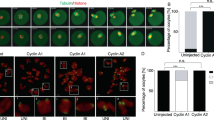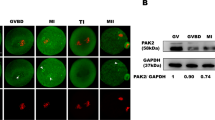Abstract
Vertebrate eggs are arrested at metaphase of meiosis II with stable cyclin B and high cyclin B/Cdc2 kinase activity. The ability of the anaphase-promoting complex/cyclosome (APC), an E3 ubiquitin ligase, to trigger cyclin B destruction and metaphase exit is blocked in eggs by the activity of cytostatic factor (CSF) (reviewed in ref. 1). CSF was defined as an activity in mature oocytes that caused mitotic arrest when injected into dividing embryos2. Fertilization causes a transient increase in cytoplasmic calcium concentration leading to CSF inactivation, APC activation, cyclin B destruction and mitotic exit3. The APC activator Cdc20 is required for APC activation after fertilization4,5. We show here that the APCcdc20 inhibitor Emi1 (ref. 6) is necessary and sufficient to inhibit the APC and to prevent mitotic exit in CSF-arrested eggs. CSF extracts immunodepleted of Emi1 degrade cyclin B, and exit from mitosis prematurely in the absence of calcium. Addition of Emi1 to these Emi1-depleted extracts blocks premature inactivation of the CSF-arrested state. Emi1 is required to arrest unfertilized eggs at metaphase of meiosis II and seems to be the long-sought mediator of CSF activity.
This is a preview of subscription content, access via your institution
Access options
Subscribe to this journal
Receive 51 print issues and online access
$199.00 per year
only $3.90 per issue
Buy this article
- Purchase on Springer Link
- Instant access to full article PDF
Prices may be subject to local taxes which are calculated during checkout




Similar content being viewed by others
References
Masui, Y. The elusive cytostatic factor in the animal egg. Nature Rev. Mol. Cell Biol. 1, 228–232 (2000)
Masui, Y. & Markert, C. L. Cytoplasmic control of nuclear behaviour during meiotic maturation of frog oocytes. J. Exp. Zool. 177, 129–145 (1971)
Murray, A. W., Solomon, M. J. & Kirschner, M. W. The role of cyclin synthesis and degradation in the control of maturation promoting factor activity. Nature 339, 280–286 (1989)
Lorca, T. et al. Fizzy is required for activation of the APC/cyclosome in Xenopus egg extracts. EMBO J. 17, 3565–3575 (1998)
Vorlaufer, E. & Peters, J. M. Regulation of the cyclin B degradation system by an inhibitor of mitotic proteolysis. Mol. Biol. Cell 9, 1817–1831 (1998)
Reimann, J. D. et al. Emi1 is a mitotic regulator that interacts with Cdc20 and inhibits the anaphase promoting complex. Cell 105, 645–655 (2001)
Sagata, N., Daar, I., Oskarsson, M., Showalter, S. D. & Vande Woude, G. F. The product of the mos proto-oncogene as a candidate ‘initiator’ for oocyte maturation. Science 245, 643–646 (1989)
Yew, N., Mellini, M. L. & Vande Woude, G. F. Meiotic initiation by the mos protein in Xenopus. Nature 355, 649–652 (1992)
Colledge, W. H., Carlton, M. B., Udy, G. B. & Evans, M. J. Disruption of c-mos causes parthenogenetic development of unfertilized mouse eggs. Nature 370, 65–68 (1994)
Hashimoto, N. et al. Parthenogenetic activation of oocytes in c-mos-deficient mice. Nature 370, 68–71 (1994)
Furuno, N. et al. Suppression of DNA replication via Mos function during meiotic divisions in Xenopus oocytes. EMBO J. 13, 2399–2410 (1994)
Gross, S. D. et al. The critical role of the MAP kinase pathway in meiosis II in Xenopus oocytes is mediated by p90Rsk. Curr. Biol. 10, 430–438 (2000)
Bhatt, R. R. & Ferrell, J. E. Jr protein kinase p90 Rsk as an essential mediator of cytostatic factor activity. Science 286, 1362–1365 (1999)
Gross, S. D., Schwab, M. S., Lewellyn, A. L. & Maller, J. L. Induction of metaphase arrest in cleaving Xenopus embryos by the protein kinase p90Rsk. Science 286, 1365–1367 (1999)
Haccard, O. et al. Induction of metaphase arrest in cleaving Xenopus embryos by MAP kinase. Science 262, 1262–1265 (1993)
Shibuya, E. K. & Ruderman, J. V. Mos induces the in vitro activation of mitogen-activated protein kinases in lysates of frog oocytes and mammalian somatic cells. Mol. Biol. Cell 4, 781–790 (1993)
King, R. W. et al. A 20S complex containing CDC27 and CDC16 catalyzes the mitosis-specific conjugation of ubiquitin to cyclin B. Cell 81, 279–288 (1995)
Sudakin, V. et al. The cyclosome, a large complex containing cyclin-selective ubiquitin ligase activity, targets cyclins for destruction at the end of mitosis. Mol. Biol. Cell 6, 185–197 (1995)
Shah, J. V. & Cleveland, D. W. Waiting for anaphase: Mad2 and the spindle assembly checkpoint. Cell 103, 997–1000 (2000)
Chen, R. H., Waters, J. C., Salmon, E. D. & Murray, A. W. Association of spindle assembly checkpoint component XMAD2 with unattached kinetochores. Science 274, 242–246 (1996)
Sharp-Baker, H. & Chen, R. H. Spindle checkpoint protein Bub1 is required for kinetochore localization of Mad1, Mad2, Bub3, and CENP-E, independently of its kinase activity. J. Cell Biol. 153, 1239–1250 (2001)
Abrieu, A. et al. Mps1 is a kinetochore-associated kinase essential for the vertebrate mitotic checkpoint. Cell 106, 83–93 (2001)
Sagata, N., Watanabe, N., Vande Woude, G. F. & Ikawa, Y. The c-mos proto-oncogene product is a cytostatic factor responsible for meiotic arrest in vertebrate eggs. Nature 342, 512–518 (1989)
Castro, A. et al. Cyclin B/cdc2 induces c-Mos stability by direct phosphorylation in Xenopus oocytes. Mol. Biol. Cell 12, 2660–2671 (2001)
Watanabe, N., Hunt, T., Ikawa, Y. & Sagata, N. Independent inactivation of MPF and cytostatic factor (Mos) upon fertilization of Xenopus eggs. Nature 352, 247–248 (1991)
Lorca, T. et al. Calmodulin-dependent protein kinase II mediates inactivation of MPF and CSF upon fertilization of Xenopus eggs. Nature 366, 270–273 (1993)
Taieb, F. E., Gross, S. D., Lewellyn, A. L. & Maller, J. L. Activation of the anaphase-promoting complex and degradation of cyclin B is not required for progression from meiosis I to II in Xenopus oocytes. Curr. Biol. 11, 508–513 (2001)
Guadagno, T. M. & Ferrell, J. E. Jr Requirement for MAPK activation for normal mitotic progression in Xenopus egg extracts. Science 282, 1312–1315 (1998)
Ferrell, J. E. Jr Xenopus oocyte maturation: new lessons from a good egg. BioEssays 21, 833–842 (1999)
Murray, A. W. Cell cycle extracts. Methods Cell Biol. 36, 581–605 (1991)
Sohaskey, M. L. & Ferrell, J. E. Jr Distinct, constitutively active MAPK phosphatases function in Xenopus oocytes: implications for p42 MAPK regulation in vivo. Mol. Biol. Cell 10, 3729–3743 (1999)
Acknowledgements
We thank T. Hunt for Xcyclin B antibodies; E. Kramer and J. Peters for XCdc20 antibodies and construct; H. Schulman for CaMKIIα cDNA; H. Yu for D-box peptide; Ferrell laboratory members for technical assistance; and J. Peters and J. Ferrell for comments on the manuscript.
Author information
Authors and Affiliations
Corresponding author
Ethics declarations
Competing interests
The authors declare that they have no competing financial interests
Rights and permissions
About this article
Cite this article
Reimann, J., Jackson, P. Emi1 is required for cytostatic factor arrest in vertebrate eggs. Nature 416, 850–854 (2002). https://doi.org/10.1038/416850a
Received:
Accepted:
Issue Date:
DOI: https://doi.org/10.1038/416850a
This article is cited by
-
Calcium ions function as a booster of chromosome condensation
Scientific Reports (2016)
-
Electron microscopy structure of human APC/CCDH1–EMI1 reveals multimodal mechanism of E3 ligase shutdown
Nature Structural & Molecular Biology (2013)
-
Mechanisms of pseudosubstrate inhibition of the anaphase promoting complex by Acm1
The EMBO Journal (2011)
-
Emi1 protein accumulation implicates misregulation of the anaphase promoting complex/cyclosome pathway in ovarian clear cell carcinoma
Modern Pathology (2008)
-
The Xenopus Cell Cycle: An Overview
Molecular Biotechnology (2008)
Comments
By submitting a comment you agree to abide by our Terms and Community Guidelines. If you find something abusive or that does not comply with our terms or guidelines please flag it as inappropriate.



